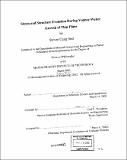| dc.contributor.advisor | Carl V. Thompson. | en_US |
| dc.contributor.author | Seel, Steven Craig, 1972- | en_US |
| dc.contributor.other | Massachusetts Institute of Technology. Dept. of Materials Science and Engineering. | en_US |
| dc.date.accessioned | 2006-03-24T18:02:25Z | |
| dc.date.available | 2006-03-24T18:02:25Z | |
| dc.date.copyright | 2002 | en_US |
| dc.date.issued | 2002 | en_US |
| dc.identifier.uri | http://hdl.handle.net/1721.1/29912 | |
| dc.description | Thesis (Ph.D.)--Massachusetts Institute of Technology, Dept. of Materials Science and Engineering, 2002. | en_US |
| dc.description | Includes bibliographical references (v. 2, leaves 283-294). | en_US |
| dc.description.abstract | To investigate stress evolution during film deposition, a novel electrical technique for in situ thin film stress measurements was developed utilizing piezoresistive silicon microcantilevers, or piezocantilevers. In addition to the thin film stress measurements of Cu made with the piezocantilevers, our collaborators at Sandia National Laboratories have studied thin film growth stresses for Al, Ag, and amorphous Ge (a-Ge) films measured using conventional laser deflectometery. A computer simulation of thin film formation by the Volmer-Weber mechanism was developed to model the nucleation and growth of individual islands that impinge and coalesce to form a continuous film. By including a size-dependent lattice contraction in pre-coalescence islands, the simulation can be used to qualitatively reproduce the measured compressive stress behavior of Al at low film thicknesses. In contrast to Al films that support stress from the very onset of deposition, Ag films exhibit no measurable stress until larger film thickness are achieved. This difference in behavior was attributed to shear occurring at the Ag-SiO2 interface, which is suppressed at the much stronger Al-SiO2 interface. Tensile stress generation resulting from island coalescence was modeled analytically and by finite element methods (FEM) as the energetic balance between interfacial energy reduction and strain energy generation resulting from grain boundary formation. The magnitude of the island-coalescence stress calculated using FEM was found to decrease dramatically with decreasing island-substrate contact angle. | en_US |
| dc.description.abstract | (cont.) Using the contact-angle-dependent FEM calculations of island-coalescence stress, simulations closely matched the stress-thickness measurements of Al, by assuming perfect island-substrate traction, and of Ag, by assuming partial island-substrate sliding, over the range of thicknesses prior to film continuity. The compressive stress evolution during deposition of continuous films and the stress behavior during interrupts of film growth was modeled in terms of a non-equilibrium surface morphology that develops during deposition. For the resulting non-equilibrium grain shapes, the in-plane compressive stress resulting from excess surface stress was calculated using FEM. Model predictions are consistent with observed decreasing compressive stress-thickness with increasing film thickness observed experimentally for Cu and a-Ge, as well as the reversible tensile rise behavior observed during growth interrupts of Cu. | en_US |
| dc.description.statementofresponsibility | by Steven Craig Seel. | en_US |
| dc.format.extent | 2 v. (294 leaves) | en_US |
| dc.format.extent | 13148711 bytes | |
| dc.format.extent | 13148511 bytes | |
| dc.format.mimetype | application/pdf | |
| dc.format.mimetype | application/pdf | |
| dc.language.iso | eng | en_US |
| dc.publisher | Massachusetts Institute of Technology | en_US |
| dc.rights | M.I.T. theses are protected by copyright. They may be viewed from this source for any purpose, but reproduction or distribution in any format is prohibited without written permission. See provided URL for inquiries about permission. | en_US |
| dc.rights.uri | http://dspace.mit.edu/handle/1721.1/7582 | |
| dc.subject | Materials Science and Engineering. | en_US |
| dc.title | Stress and structure evolution during Volmer-Weber growth of thin films | en_US |
| dc.type | Thesis | en_US |
| dc.description.degree | Ph.D. | en_US |
| dc.contributor.department | Massachusetts Institute of Technology. Department of Materials Science and Engineering | |
| dc.identifier.oclc | 51720063 | en_US |
